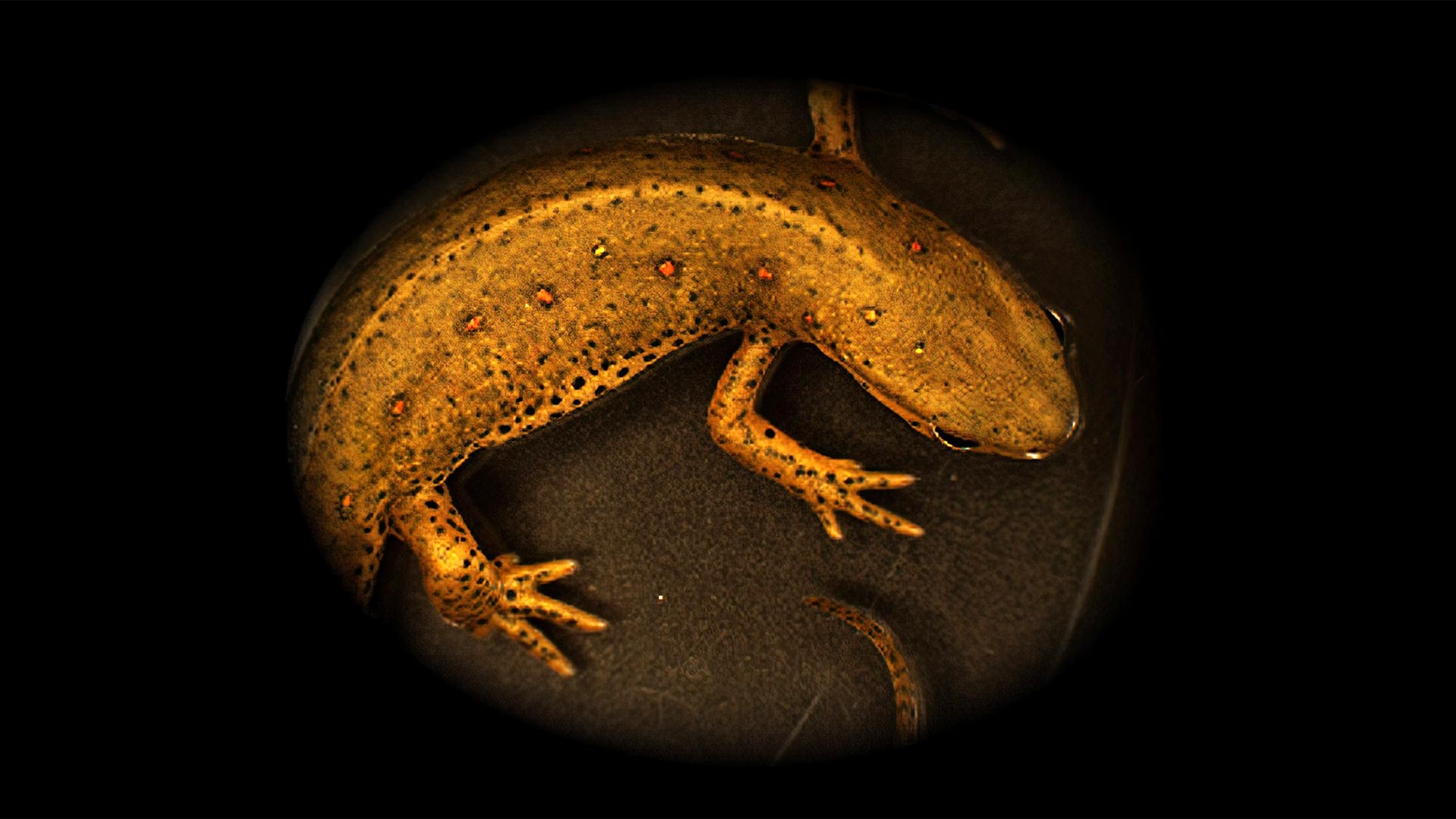

A Yoon csoportja által vizsgált szalamandrafaj: Vörösfoltos szalamandra Notophthalmus viridescens. A figyelemre méltó regenerációs képességekkel rendelkező szalamandrák tanulmányozásával a kutatók felfedezték, hogy az öregedő sejtek jelenléte felgyorsítja a végtagok regenerálódását. A sejtek olyan faktorokat választanak ki, amelyek jelzik, hogy az érett izomrostok korábbi izomsejtekké alakulnak át, ami elősegíti a regenerációt. Ez a felfedezés segíthet a kutatóknak megérteni, miért korlátozottak az emberek regenerációs képességei, és esetleg új kezelési módokat dolgozhatnak ki az életkorral összefüggő betegségekre. Kredit: Maximina Yun
A tudósok kimutatták, hogy az úgynevezett öregedő sejtek, vagyis az osztódást végleg leállt sejtek elősegítik az új izomsejtek termelődését, hogy elősegítsék a szalamandra elvesztett végtagjainak regenerálódását.
Az öregedő sejtek, amelyek az öregedéssel és betegségekkel kapcsolatosak, regeneráló tulajdonságokkal rendelkezhetnek. A szalamandrák tanulmányozása során a kutatók azt találták, hogy az öregedő sejtek felgyorsítják a végtagok regenerálódását azáltal, hogy jelzik az izomrostok differenciálódását, ami új kezelésekhez vezethet az életkorral összefüggő betegségek kezelésére.
Az öregedő sejtek olyan sejtek, amelyek osztódása végleg leállt a celluláris stressz hatására, de nem pusztultak el. Ahogy az élőlények öregszenek, az öregedő sejtek száma nő a szervezetben. Ezt a felhalmozódást jelenleg az öregedés fémjelének tekintik, és számos betegséggel, köztük a rákkal is összefüggésbe hozható. Ezeknek a sejteknek a valódi természete azonban összetettebb és kontextusfüggő lehet.
Egyre több bizonyíték utal arra, hogy az öregedő sejteknek jótékony hatásai is lehetnek, mint például a sebek gyógyulása vagy a szöveti hegesedés megelőzése. „Néhány évvel ezelőtt a mi csoportunk azt találta, hogy az öregedő sejtek jelen vannak a szalamandra végtagok regenerációjának kulcsfontosságú szakaszaiban. Érdekes módon más csoportok később más regenerációs kontextusokban is megtalálták ezeket a sejteket, beleértve az emlősöket is. Ezért azt akartuk látni, hogy ezek a sejtek hozzájárulnak-e Bármilyen módon meg tud újulni” – magyarázza Dr. Maximina Yon, a Drezdai Regeneratív Terápiák Központjának (CRTD) és a Physics of Excellence (PoL) csoportjának vezetője a Drezdai Egyetemen és a Max Planck Intézetben.[{” attribute=””>Molecular Cell Biology and Genetics (MPI-CBG).
Senescent Cells Promote Regeneration
The researchers in Yun’s group study salamanders. These animals have unique regeneration abilities and are able to re-grow many organs of their bodies, including lost limbs. “Salamander limb regeneration is a fascinating process. In a matter of weeks, they re-grow a fully functional limb,” explains Dr. Yun.
To check if the presence of senescent cells influences the limb regeneration process, researchers in the Yun group found a way to modulate the number of senescent cells in the wound. The team observed that the presence of senescent cells enhanced the regeneration process.
“When more senescent cells were present in the wound, the animals developed a larger regeneration bud, or – as we call it – blastema. This is a collection of cells that are going to form all the needed tissues in the new limb. The larger the blastema, the more cells are there to regrow the limb and the quicker the regeneration process. The presence of senescent cells seemed to ‘fuel’ the regeneration process,” Dr. Yun says.
“Zombie” Signaling Promotes New Muscle Cells
Looking more closely at the blastema with and without the influence of the senescent cells, the Yun team uncovered a new mechanism that enhances the regeneration process and found that the presence of senescent cells increased the number of regenerating muscle cells. They showed that senescent cells secrete factors that stimulate nearby muscle tissue to take a developmental step back and produce new muscle.
“Our results show that senescent cells use cell-cell communication to influence the regeneration process. They secrete molecules that signal to mature muscle fibers to dedifferentiate into muscle progenitor cells. These cells can multiply themselves as well as differentiate into new muscle cells, thereby enhancing the regeneration process. This signaling appears to be an important part of promoting regeneration,” says Dr. Yun.
For now, the group focused on muscle, one of the most important tissues in the regenerating limb. However, the team is already investigating whether senescent cell signaling also contributes to the regeneration of other tissues.
Lessons From the Salamanders
Yun’s group is working with salamanders to study regeneration and aging processes. “Salamanders are one of the few animal species that seem to defy the natural aging process. They do not develop typical signs of aging and do not accumulate age-related diseases such as cancer. They also have extraordinary healing abilities,” says Dr. Yun. The animals can regenerate almost any organ in their body.
Studying salamanders is helping Dr. Yun and her colleagues at the CRTD understand the principles of the regeneration process and, in the long run, may help solve the puzzle of why humans have very limited regenerative abilities.
Reference: “Senescent cells enhance newt limb regeneration by promoting muscle dedifferentiation” by Hannah E. Walters, Konstantin E. Troyanovskiy, Alwin M. Graf and Maximina H. Yun, 6 April 2023, Aging Cell.
DOI: 10.1111/acel.13826

„Utazási specialista. Tipikus közösségi média tudós. Az állatok barátja mindenhol. Szabadúszó zombinindzsa. Twitter-barát.”





More Stories
A SpaceX Polaris Dawn űrszondájának legénysége a valaha volt legveszélyesebb űrsétára készül
Egy őskori tengeri tehenet evett meg egy krokodil és egy cápa a kövületek szerint
Egyforma dinoszaurusz-lábnyomokat fedeztek fel két kontinensen